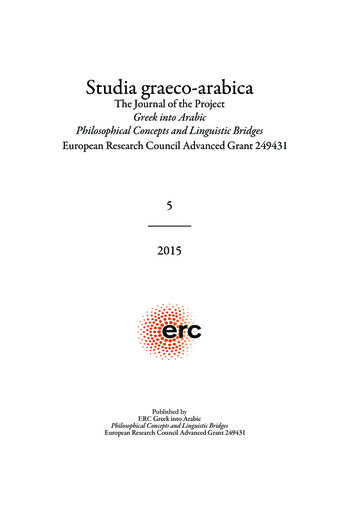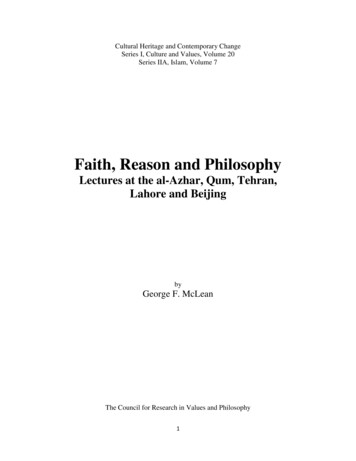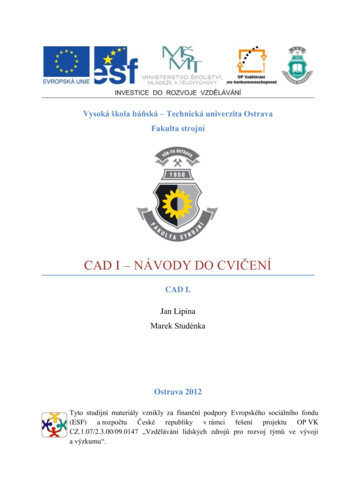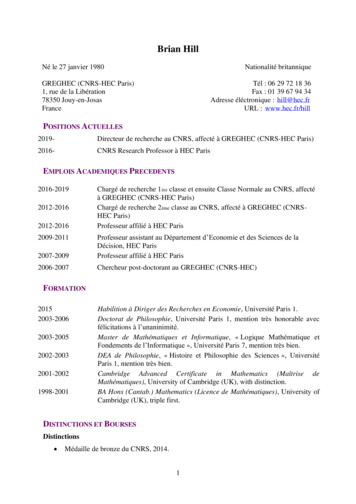
Transcription
Studia graeco-arabicaThe Journal of the ProjectGreek into ArabicPhilosophical Concepts and Linguistic BridgesEuropean Research Council Advanced Grant 24943152015Published byERC Greek into ArabicPhilosophical Concepts and Linguistic BridgesEuropean Research Council Advanced Grant 249431
AdvisorsMohammad Ali Amir Moezzi, École Pratique des Hautes Études, ParisCarmela Baffioni, Istituto Universitario Orientale, NapoliSebastian Brock, Oriental Institute, OxfordCharles Burnett, The Warburg Institute, LondonHans Daiber, Johann Wolfgang Goethe-Universität Frankfurt a. M.Cristina D’Ancona, Università di PisaThérèse-Anne Druart, The Catholic University of America, WashingtonGerhard Endress, Ruhr-Universität BochumRichard Goulet, Centre National de la Recherche Scientifique, ParisSteven Harvey, Bar-Ilan University, JerusalemHenri Hugonnard-Roche, École Pratique des Hautes Études, ParisRemke Kruk, Universiteit LeidenConcetta Luna, Scuola Normale Superiore, PisaAlain-Philippe Segonds (†)Richard C. Taylor, Marquette University, Milwaukee (WI)StaffElisa CodaCristina D’AnconaCleophea FerrariGloria GiacomelliCecilia Martini Bonadeostudiagraecoarabica@greekintoarabic.euWeb site: http://www.greekintoarabic.euService Provider: Università di Pisa, Area Serra - Servizi di Rete AteneoISSN 2239-012X (Online) Copyright 2015 by the ERC project Greek into Arabic (Advanced Grant 249431).Studia graeco-arabica cannot be held responsible for the scientific opinions of the authors publishing in it.All rights reserved. No part of this publication may be reproduced, translated, transmitted in any form or byany means, electronic, mechanical, photocopying, recording or otherwise, without prior written permissionfrom the Publisher.Registration at the law court of Pisa, 18/12, November 23, 2012.Editor in chief Cristina D’Ancona.CoverMašhad, Kitābḫāna-i Āsitān-i Quds-i Raḍawī 300, f. 1vParis, Bibliothèque Nationale de France, grec 1853, f. 186vThe Publisher remains at the disposal of the rightholders, and is ready to make up for unintentional omissions.
399Book AnnouncementsThe Routledge Handbook of Neoplatonism, ed. by P. Remes and S. Slaveva Griffin, Routledge, London –New York 2014 (Routledge Handbooks in Philosophy), xi 644 pp.This multi-authored volume falls into seven main parts, each of them comprised of a number of shortchapters. Parts I and II account for the historical and doctrinal background of Neoplatonism, but theoverarching approach of the Handbook is thematic: Parts III to VI deal in succession with the One, theintelligible substance, soul and the related epistemological issues, the physical world, and finally with ethics andpolitics, thus following the deductive pattern from the One to the many laid down by E. Zeller in the chapteron Plotinus of his Die Philosophie der Griechen, adopted afterwards in virtually all the systematic presentationsof Neoplatonism. To this familiar layout some new entries are added, dictated by contemporary debates suchas that on “animal minds”, surfacing in Part VI. Part VII is devoted to the influence of Neoplatonism until theMiddle Ages (Christian, Islamic, and Hebrew). In their Introduction (pp. 1-10) P. Remes and S. Slaveva-Griffinpoint out that their aim is less that of providing “summaries of research” than of offering “an opportunity tocirculate new ideas or to defend a recently opposed view” (p. 9). The spirit of the volume becomes especiallyprominent in the Introduction to Part III, where it is phrased as follows: “The changing fates of Neoplatonism,from a late esoteric appendage to the Classical period of ancient philosophy to an up-and-coming vibrant field,is ostensibly a result of the advances we have made in understanding Neoplatonic metaphysics, the heart ofhearts of Neoplatonism” (p. 163).Part I, “(Re)sources, instruction and interaction” (pp. 13-99) deals with the doctrinal and institutionalbackground of Neoplatonism. The first chapter, by H. Tarrant, is devoted to “Platonist curricula and theirinfluence” (pp. 15-29), and pivots on the idea of the continuity of the reading order of Plato’s dialogues, not only– and predictably – from the so-called “canon of Iamblichus” onwards, but even before: “what is remarkable ishow little the Platonic curriculum changed, not just after Iamblichus, but even since Plutarch of Chaeronaea”(p. 27). R. Sorabji, “The Alexandrian classrooms excavated and sixth-century philosophy teaching” (pp. 309) explores the consequences for the history of philosophy of the Polish excavations at Alexandria, that have“identified the surprisingly well-preserved lecture rooms of the sixth-century Alexandrian school” (p. 30).The account of the teaching activities in late antique Alexandria gives R. Sorabji the opportunity to expresshis views on the question of the unanimity versus difference between the two main philosophical schools ofthe 5th-6th centuries: “Ammonius’ reticence about religious practice differentiated him from the devotionalenthusiasm of Iamblichus, and of the Athenian school notably under Proclus, and I believe this gives truth tothe controversial claim that the Alexandrian school was different in character from the Athenian”, (pp. 36-7;on this issue one may have a look at the review by the present writer of the book by I. Hadot, pp. 375-83). G.Reydams-Schils and F. Ferrari, “Middle Platonism and its relation to Stoicism and the Peripatetic tradition”(pp. 40-51) explore the technique and the various kinds of the Platonist “co-optation”, meaning with thisterm a “strategy” to establish the truth of Plato’s philosophy by showing that in the doctrines of the rivalschools (with the notable exception of Epicureanism) are embedded parts of that truth that only by Plato wasexpounded as a consistent whole. J.D. Turner, “Plotinus and the Gnostics: opposed heirs of Plato” (pp. 52-76)presents his opinion – already advanced in the 2001 volume Sethian Gnosticism and the Platonic Tradition –that the Gnostic treatises read in Plotinus’ circle were the source of the latter’s derivational scheme. Turner isobviously aware of the harsh criticism addressed to the Gnostics by Plotinus, in particular in treatise II 9[33],but he finds in him a “mixture of acquiescences, objections and corrections” (p. 63) with respect to the Gnosticdoctrines, especially as expounded in the “Sethian” treatises. Faced with II 9[33], Turner is ready to admit that“it may be that Plotinus’ encounter with the Gnostics also caused him to tighten up on his own doctrines”(ibid.). V. Adluri, “Plotinus and the Orient: aoristos dyas” (pp. 77-99) engages in a comparative assessment ofPlotinus’ doctrines and “the Indian system of thought” (p. 77), without however raising the question whether Copyright 2015 Greek into Arabic (ERC ADG 249431)Studia graeco-arabica 5 / 2015
400 Reviews & Book Announcementsor not, and in case it does to what extent Plotinus was acquainted with such doctrines. Adluri’s conviction isthat “The question of Plotinus’ Orientalism thus cannot be settled by geographic or historical investigations,because the question is fundamentally not a positive question. It is a conceptual question inasmuch as it pertainsto our definitions of ‘Occidental’ (or ‘Greek’ or ‘Western’) and ‘Oriental’ ” (p. 92, author’s emphasis).Part II, “Methods and Styles of Exegesis” (pp. 103-59) works with the assumption of the “highly ermeneuticalnature” (p. 103) of the Neoplatonic philosophical enterprise best exemplified by Plotinus’ well-known passagein V 1[10], 8.11-15 (quoted ibid.) that “these statements of ours are not new; they do not belong to the presenttime, but were made long ago, not explicitly, and what we have said in this discussion has been an interpretationof them, relying on Plato’s own writings for evidence that these views are ancient” (trans. Armstrong). Thispart contains the chapter “Aristotelian commentary tradition” by H. Baltussen (pp. 106-14), pointing to therise and development of the running commentary, first in the Aristotelian tradition and then in the Platonicone. Baltussen sides with the view advanced by I. Hadot that a standard canon of readings imposed itself inNeoplatonism: “Platonist exegesis of Aristotle’s works was intended to prepare the minds of students for themore important ideas of Plato. The inversion of the historical relation was justified with traditional and doctrinalarguments: after the moral training (reading Epictetus’ Handbook) the ‘smaller mysteries’ of Aristotle’s workswould lead from a better understanding of words and concepts (Categories, On Interpretation) and the physicalworld (Physics, On the Heavens) to the metaphysical understanding of Plato’s philosophy” (p. 113). In his “Thenon-commentary tradition” (pp. 115-25) A. Smith points to the fact that “From the time of Porphyry onwardsever-increasing attention was paid both within the schools of the Neoplatonists and in their publications to thereading and careful commentary of Platonic texts. By the time of Iamblichus a carefully ordered programmeof Platonic texts was in place. But the activity of the philosophers in the schools continued to require otherforms of communication. By means of letters, exhortatory works, general introductions, compendia, polemicaltreatises and large-scale comprehensive works they engaged with the society in which they lived, with their fellowphilosophers and with their students” (p. 117). Examples of this non-commentary tradition are the Letters,like Porphyry’s To Marcella, the Introductions to philosophy, like Iamblichus’ Protrepticus, the Summarieslike Porphyry’s Sentences, or Sallustius’ On the Gods and the Universe, or even Proclus’ Elements of Theologyand finally, notwithstanding the substantial differences with the woks just mentioned, his Platonic Theology. L.Brisson, “Plotinus’ style and argument” (pp. 126-44) presents Plotinus’ biography and works, accompanied by ananalysis of his grammar and syntax based on the reference work on the topic, namely the section “Sprache” in theentry “Plotinos” written by H.-R. Schwyzer for the Pauly-Wissowa Realenzyklopädie für Altertumswissenschaft(1951). After Schwyzer’s foundational study, a detailed and helpful research was published by F. Phillips, TheProse Style of Plotinus. Rhetoric and Philosophy in the Enneads (Madison 1980), which however is not takeninto account in this chapter. M. Martijn, “Proclus’ geometrical method” (pp. 145-9) challenges the idea thatProclus did follow an axiomatic-deductive style of argumentation. In Martijn’s views, the geometrical methodhas only a didactic aim, and this is the meaning conveyed by the term στοιχείωσις, elementatio. “In sum, then,any Elements is a concise introductory teaching, which, for didactic reasons, consists of first principles (if any)and derivations (or deductions), presented in the proper order: any deduction should be made using only theprinciples and what has already been established” (p. 147, author’s emphasis). If so, “Geometry provides an idealmethodological paradigm, better than either dialectic or empty logic ( ), because of the geometry’s intermediateposition in between the sensible and the intelligible, It combines a rigid structure reflecting the order of realitywith the power of reversion to higher levels of reality” (p. 156).With Part III, “Metaphysics and metaphysical perspectives” (pp. 163-244) begins the theoretical analysisthat forms the main focus of this volume. In her “Metaphysics: the origins of becoming and the resolution ofignorance” (pp. 166-81) S. Ahbel-Rappe advocates the idea that “Neoplatonic metaphysics does more than tella story; it is illocutionary as well as indexical, in so far as it tells us how to see the world and how things got totheir present state, and offers a corrective for our current condition, namely ignorance. ( ) For this reason, thelanguage of Neoplatonic metaphysics is best understood as promissory, offering a glimpse of reality, a preludeto genuine knowledge” (pp. 166-7). Working with this assumption, Rappe offers a survey of the metaphysicalviews from Plotinus to Damascius. The Plotinian doctrine of the One is dealt with by J. Halfwassen, “TheMetaphysics of the One” (pp. 182-99). The foundations of being are, for Plotinus, in the One; HalfwassenStudia graeco-arabica 5 / 2015
Reviews & Book Announcements 401explores the philosophical meaning and implications of this theory. Starting with an interesting comparisonwith Kant’s point of view apropos thought and unity, he offers an insight of Plotinus’ way of understand thisrelationship: “No one can dispute that everything which can be conceived of, can only be conceived of as aunity, because everything which is conceivable must be defined and definition is only possible as a unity. ( )However, it is precisely here that an objection might be suggested. One could perhaps argue, just like Kant,that unity is the highest principle of our reasoning faculty, by means of which we order reality according tounitary points of view, because we could not grasp them otherwise ( ). However, it does not necessarily followfrom this requirement of unity on the part of our thought that reality by itself, independent of our thought,must be a unity and must be ordered according to a unitary perspective. For Kant, the final basis for unity ofour thought-forms is the unity of the thinking Self. ( ) Interstingly, Plotinus also poses the question whetherThought itself first spawns unity, without which nothing can be thought ( ). He, then, clearly formulates thealternatives: to interpret our thought’s requirement for unity either subjectively, as a consolidation of Thoughtitself, or realistically and ontologically, as the perception of the unitary character of Being itself ( ). Plotinusprovides a quasi-transcendental analysis of the conditions for the possibility of our thought” (pp. 183-4). Thetypical move of Neoplatonic metaphysics, best exemplified by Plotinus, is that of locating this preconditionfor being and thought beyond being and thought. To this is devoted the final part of Halfwassen’s chapter. S.Slaveva-Griffin, “Number in the metaphysical landscape” (pp. 200-15) examines “the Neoplatonist’s expansiveinterest in the constitutional role of number and maps the metaphysical landscape according to the ontologyof number in the thought of its most avid proponents: Plotinus, Iamblichus, Syrianus and Proclus” (p. 200).The subsets of this analysis, “Number in Plotinus’ metaphysics”, then “Number in Iamblichus’ metaphysics”,then again in Syrianus and Proclus, elicit the conclusion that “Starting with Iamblichus, the later Platonistsindefatigably strive to close the gap between the applied sciences of mathematics and its ontological dimension”.Thus, they proceed “[f]rom the quantifiable heterogenic multiplicity of the physical world, to the unquantifiablehomogenic multiplicity of the metaphysical realm, to the highest productive principle of existence” (p. 212). R.Chiaradonna’ s chapter, “Substance” (pp. 216-30) offers an analysis of late antique views of οὐσία. “Plotinus’tripartite treatise On the Genera of Being (VI 1-3 [42-44]) laid the basis for subsequent accounts. ( ) [I]n theGenera of Being Plotinus ( ) argues that ousia is only properly referred to intelligible being, whereas what isimproperly called ousia in the sensible realm does not satisfy the requirements of primary being and henceis ousia only homonymously” (pp. 217-8). This view is compared with another, earlier stage of the Platonistattempt to manage the divide between the Platonic and Aristotelian understanding of what primary being is –the intelligible realm, or the ontological foundation of individual substance. Chiaradonna aptly points out that“What we know of the early Platonic-Pythagorean reception of Aristotle’s Categories in the first century BCE( ) points instead to a different direction. At that early stage, Aristotle’s categories were probably incorporatedwithin a Platonic-Pythagorean doctrinal framework: some of Aristotle’s views were indeed criticized or adapted,but the distinction between intelligible and sensible beings was not used against his division” (p. 219). Againstthis backdrop, what is distinctive of Plotinus is that he raises “questions internal to the Peripatetic theory ofsensible substance. ( ) Plotinus argues that Aristotle’s account of ousia is not only incomplete (for one shouldsupplement Aristotle’s sensible ousia with Plato’s separate substance), but also self-refuting: while Peripateticsclaim that ousia has a primary status over what depends on it, they cannot ground this priority” (pp. 221-2,author’s emphasis). A survey of the positions of later Neoplatonists follows, that ends with Simplicius and withthe remark that in the latter “Plotinus’ account of ousia is thus completely reversed” (p. 227). J.-M. Narbonne,“Matter and evil in the Neoplatonic tradition” (pp. 231-44) explores the “role of matter as a possible sourceof evil” (p. 231) in the Neoplatonic tradition as compared with classical Greek thought. The main differenceis the “derivative character of matter” (ibid.), grounded in Neopythagoreanism and maintained also inGnosticism, by Numenius, in the Chaldaean Oracles, and by Plotinus. Radical dualism entails that matter is arival principle with respect to the principle of the good; conversely, in an “integral emanative system such asthe one advocated by our Neoplatonic philosophers (p. 232) matter derives from the unique principle of thegood. Thus the problem arises “Whence comes evil, if there exists no independent principle of evil?” (ibid.).Plotinus’ response, according to Narbonne, is “mixed dualism”, namely the idea that “evil does not come fromthe first principle, but exclusively from the second; evil manifested as real force, although it remains less thanStudia graeco-arabica 5 / 2015
402 Reviews & Book Announcementsthe force of the Good” (p. 236). As a consequence, “The evil cannot be totally outside being (because there isno such outside), but it cannot be inside either, since it is radically opposed to being” (p. 237). The chapter endswith an analysis of the criticisms raised against this theory, especially by Proclus in his monograph De Malorumsubsistentia, where he presents his peculiar solution: evil, like accidents, has no being properly speaking, butonly a sort of parasitical form of being: parhypostasis, “adventitious existence”.Part IV, “Language, Knowledge, soul and self” (pp. 247-338) explores “the central role that the soul plays inNeoplatonic philosophy, both in metaphysics and cosmology as well as philosophical anthropology and theoriesof cognition and knowledge” (p. 247). In his “The gift of Hermes: the Neoplatonists on language and philosophy”(pp. 251-65) R.M. van den Berg deals with the opinions held by Neoplatonists on human language and itsrelationship with intelligible items. Van den Berg begins with the judicious remark that “This chapter will not beabout anything like a ‘Neoplatonic philosophy of language’ for the simple reason that there is no such thing”(p. 251), and carries on an analysis of the reception of the ideas about language held by Plato – a linguistic“naturalist” – and by Aristotle – a linguistic “conventionalist”. The ways in which the Neoplatonists “dealt withthe tension between the two accounts” (p. 252) vary from Plotinus’ little or no concern for the ways in which onemight harmonize Plato and Aristotle on this issue, to the post-Plotinian efforts to establish a common ground forboth the Cratylus and the De Interpretatione. A clearly different stance appears between those philosophers whoworked with the assumption of the harmony of Plato and Aristotle, and those who did not. Ammonius’commentary on the De Interpretatione provides a good example of the first stance; Proclus commentary on theCratylus, of the second. “Ammonius tried to interpret away Aristotle’s claim that language is meaningful byconvention only and that names are nothing but symbols, in order to be able to harmonize it with Plato’s claimthat names are meaningful by nature. Proclus, on the other hand, did not so much try to harmonize Plato andAristotle, but rather tried to separate them and accord them their own domain. Aristotle’s entire philosophy, hislogic and ideas about language included, bears on the physical world of particulars, that of Plato on the intelligiblerealm of Forms” (p. 264). After an outline of the Plotinian doctrine of human cognition, L.P. Gerson,“Neoplatonic epistemology: knowledge, truth and intellection” (pp. 266-79) narrows his focus on the positionsof post-Plotinian philosophers who did not accept Plotinus’ idiosyncratic doctrine of the undescended soul.“Rejecting the idea that our intellects are undescended, Ammonius and his followers were led to reflect on howour descended intellects operate in relation to intelligibles and hence how knowledge is possible for embodiedpersons. ( ) [T]he possibility occurs that Ammonius and his school are appealing to Aristotle’s active intellectto account for embodied higher cognition. ( ) This actualization, however, is not the identification of theintellect with the intelligibles, as it is for Plotinus in the undescended intellect ( ). Rather, the actualization is ofa representation of those intelligibles ( ). So, the actualization of the intelligible or intelligibles in the intellect isa representational state. The object of knowledge is the content of the representation, not the intelligible itself.The knoweldge is the identification of the intellect with the act of representing” (pp. 276-7), admittedly a highlyun-Plotinian conclusion. In Gerson’s account of the reasons why the post-Plotinian Neoplatonists partedcompany with the theory of the undescended soul Iamblichus plays no major role; on the contrary, the latter isthe pivot of the post-Plotinian account of soul in the paper by J.F. Finamore, “Iamblichus on soul” (pp. 280-92).At variance with Plotinus, Iamblichus maintains that when the soul is engaged in activities connected with thebody, it does not “remain” connected with the intelligible realm. “The Iamblichean universe is a complex place.Above the Forms and the Intelligible is the One itself. Below the Intellect are a series of psychic intermediaries(visible gods, angels, daemons, heroes, purified human souls). The human soul was placed far apart from the Oneand Intellect, adrift in the world of becoming. The soul could not ascend back to its intelligible home withoutdivine aid. Such aid was available through sacred rites and theurgical practices. As Iamblichus makes clear inMyst. V.18, the largest segment of humanity is held down by nature, is subject to fate, and never rises” (p. 289).Another point to notice in Finamore’s article is his position about the authorship of a commentary on theDe Anima ascribed to Simplicius, a text which heavily borrows from Iamblichus: in Finamore’s view, the questionremains still open, and for this reason he refers to the positions expounded in this commentary as Simplicius’. Inhis “From Alexander of Aphrodisias to Plotinus” (pp. 293-309) F.M. Schroeder argues that the basic differencebetween Alexander and Plotinus consists in that the former is a dualist while the latter is a monist, a differencethat according to Schroeder bears importantly also on the respective views of intellection. First SchroederStudia graeco-arabica 5 / 2015
Reviews & Book Announcements 403compares Alexander’s and Plotinus’ accounts of the role of the diaphanous in vision; then he moves to theirrespective ways to use the metaphor of “illumination” in the explanation of how human intellection occurs. Eventhough in note 2 (p. 307) Schroeder advances the hypothesis that the “Alexander” famously mentioned byPorphyry (VP 14.13) as one of the commentators of Aristotle that Plotinus wanted to have read before he startedhis lecture was not Alexander of Aphrodisias but his father, it is indeed with Alexander of Aphrodisias that thecomparison is conducted. Only with his De Anima, however: the De Intellectu is deliberately not taken intoaccount, because Schroeder is convinced that this writing is not by Alexander; rather, he ascribes it to a laterauthor influenced by Plotinus (cf. n. 41, p. 309). According to Schroeder, “The fundamental difference betweenPlotinus and Alexander is that, where Alexander is a dualist, Plotinus is a monist. The distinction is manifestedin their different accounts of the physics of light. It is also at work in their respective epistemologies. ( ) In thedualistic account of Alexander the Active Intellect is, in its cooperation with the human intellect, the efficientcause for the abstraction of form from matter, and the Active Intellect is the final cause of that evolution of thehuman mind that progresses to that moment. ( ) In the monistic version of Plotinus, the One (correspondingto the Active Intellect in Alexander) is the efficient cause of Intellect. It is also the final cause of the return ofIntellect (and ultimately of our return) to the One” (p. 307). G. Aubry, “Metaphysics of soul and self in Plotinus”(pp. 310-22) attempts a philosophical treatment of Plotinus’ notion of ἡμεῖς – the “self” – as distinct from thesoul. “This philosophical breakthrough is inseparable from the discovery of immediate reflexivity; that is, thesubject’s ability to apprehend itself independently of its relation to an object or to another subject” (p. 310). Thisdiscovery creates, in Aubry’s view’s, a “gap between soul and self” that forms the core of this article. After a surveyof the “levels” of the soul in Plotinus, their relationship with “self” is described. The notion of “self” is akin toconsciousness: “[T]he association of hēmeis with consciousness prohibits the identification of it with any specificlevel of soul. At the same time, Plotinus thus provides himself with a graduated conception of the subject, sincehe distinguishes between the hēmeis and the intellibile ‘self’. It is in the latter – identical to pure ousia, that is, theseparated soul – that the foundation of individuality resides, together with the most intense life and an unalterablehappiness” (p. 321). The main purpose of P. Lautner, in his “Perceptual awareness in the ancient commentators”(pp. 323-38) is to explain the late antique interpretation of De Anima III 2, where Aristotle distinguishes betweenperception and perceptual consciousness. “The commentators in late antiquity share Aristotle’s conviction thatperception is not the same as perceptual awareness” (p. 324). Taking as his starting point a passage of thecommentary on De Anima III that is transmitted together with Philoponus’ commentary, but whose author wasin all likelihood Stephanus of Alexandria, Lautner surveys the positions of the philosophers mentioned in it, whoheld specific ideas on the relationship between perception and perception of perception. Thus, Alexander ofAphrodisias, Plutarch of Athens, and the “more recent” commentators Proclus and Damascius are taken intoaccount. Then the position of the author of this doxography, aptly labelled “pseudo-Philoponus”, is analyzed.Also the position expounded in a commentary ascribed to Simplicius is analyzed; its author is labelled – onceagain aptly in the opinion of the present writer – “pseudo-Simplicius”. Finally, the position of Priscianus of Lydiais taken into account. Lautner’s presentation of the doctrine of Pseudo-Philoponus counts as a synthesis of theNeoplatonic exegesis of Aristotle’s perceptual awareness: “Pseudo-Philoponus thinks it is impossible that thesame sense should know that it sees. He develops an argument to the effect that, if it can revert to itself (this iswhat perceptual awareness means to him), the power of perception is both immortal and incorporeal. ( )Moreover, the senses are not eternal, since they are tied to bodily organs. Therefore, they cannot revert tothemselves. As a consequence, it is the rational part of the human soul to apprehend that we are perceiving. It isthe attentive part that has this job. The thesis clearly goes against the Aristotelian assumptions” (p. 331).The Neoplatonic conception of the visible world that is dealt with in Part V, “Nature: physics, medicineand biology” (pp. 341-90) is presented as part and parcel of a general system consisting “of two-way dynamicprocesses which unfold downward to instantiate the physical world and revert upward to confirm the ontological‘goodness’ of this instantiation” (p. 341). A. Linguiti, “Physics and metaphysics” (pp. 343-55) discusses the ideathat Plotinus and other Neoplatonists display little interest in the physical world. In some sense, this is true:the Neoplatonists “concentrate on causes, or principles, which differ by nature from physical bodies, in thatthey are incorporeal, immaterial, ‘spiritual’ and located in an order of reality that is not the same as the oneallotted to bodies” (p. 343). However, the very fact that “[a]ccording to Plotinus and his followers ( ) theStudia graeco-arabica 5 / 2015
404 Reviews & Book Announcementsphysical world never emancipates itself from its metaphysical causes, which relentlessly and pervasively keepon operating within it” (p. 344) makes the realm of nature also the realm of the instantiated logos. Through adescription of the “Features of the sensible world” and of the “Causes and genesis” that Plotinus and Proclusgrant to the world of coming-to-be and passing away, Linguiti reaches the conclusion that the Neoplatonicphilosophy of nature is “eminently ‘rationalistic’, which is to say based on deductive inferences leading fromintelligible principles all the way down to natural phenomena” (p. 352). In his “Neoplatonism and medicine”(pp. 356-71), J. Wilberding challenges the “rather uncharitable view of the Neoplatonic project, accordingto which the sensible wolrd fails to warrant any sustained scientific investigation on account of its being amere image of the true object of
arguments: after the moral training (reading Epictetus' Handbook) the 'smaller mysteries' of Aristotle's works would lead from a better understanding of words and concepts (CategoriesOn Interpretation, ) and the physical world (Physics, On the Heavens) to the metaphysical understanding of Plato's philosophy" (p. 113). In his "The










